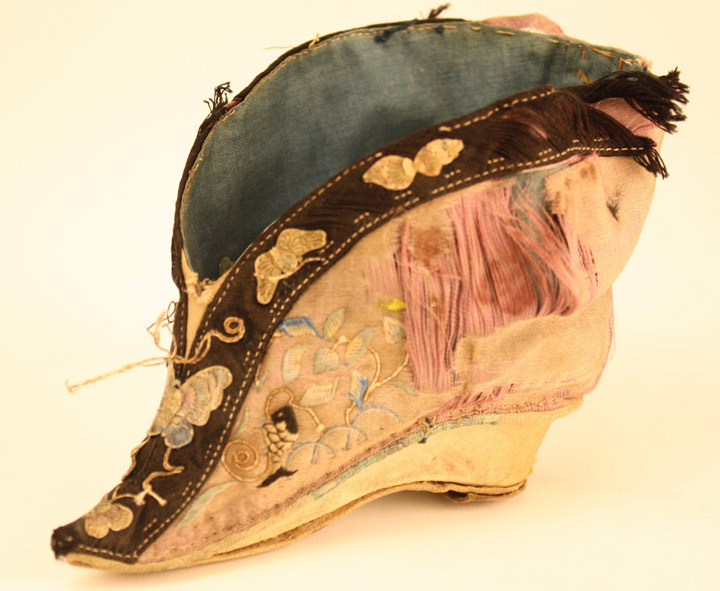Bound Feet Shoes, Tourist Souvenir, China
These little shoes are made from deep green brocade with designs of foliage, boats and pagodas. They are very tiny – only 14cm long. At first glance they might be children’s shoes but notice that they have a very large opening at the ankle. These are actually a type of shoe designed for bound feet, which was a custom in some parts of China for many years.
Many cultures value small feet in women – think of Cinderella’s dainty feet compared to her wicked stepsisters. In China tiny, narrow feet in women were considered very beautiful, as were small dainty movements. In order to achieve this, girls would have their feet tightly bound to prevent normal growth. This process began when the girl was between two and five years old and before her feet were fully formed. The bindings had to be changed regularly but foot infections were very common. The process was extremely painful as essentially the feet were moulded and compressed into the desired shape; toes were folded and compressed under the foot and sometimes broken. The child had to walk on her bound feet to crush them into shape.
Many cultures value small feet in women – think of Cinderella’s dainty feet compared to her wicked stepsisters. In China tiny, narrow feet in women were considered very beautiful, as were small dainty movements. In order to achieve this, girls would have their feet tightly bound to prevent normal growth. This process began when the girl was between two and five years old and before her feet were fully formed. The bindings had to be changed regularly but foot infections were very common. The process was extremely painful as essentially the feet were moulded and compressed into the desired shape; toes were folded and compressed under the foot and sometimes broken. The child had to walk on her bound feet to crush them into shape.
This tradition was finally banned in the early 20th Century. These shoes were made for the tourist trade, the image below shoes an original example in the collection.
Length:10cm

Length:14cm

Length:14cm

These little shoes are made from deep green brocade with designs of foliage, boats and pagodas. They are very tiny – only 14cm long. At first glance they might be children’s shoes but notice that they have a very large opening at the ankle. These are actually a type of shoe designed for bound feet, which was a custom in some parts of China for many years.
Many cultures value small feet in women – think of Cinderella’s dainty feet compared to her wicked stepsisters. In China tiny, narrow feet in women were considered very beautiful, as were small dainty movements. In order to achieve this, girls would have their feet tightly bound to prevent normal growth. This process began when the girl was between two and five years old and before her feet were fully formed. The bindings had to be changed regularly but foot infections were very common. The process was extremely painful as essentially the feet were moulded and compressed into the desired shape; toes were folded and compressed under the foot and sometimes broken. The child had to walk on her bound feet to crush them into shape.
Many cultures value small feet in women – think of Cinderella’s dainty feet compared to her wicked stepsisters. In China tiny, narrow feet in women were considered very beautiful, as were small dainty movements. In order to achieve this, girls would have their feet tightly bound to prevent normal growth. This process began when the girl was between two and five years old and before her feet were fully formed. The bindings had to be changed regularly but foot infections were very common. The process was extremely painful as essentially the feet were moulded and compressed into the desired shape; toes were folded and compressed under the foot and sometimes broken. The child had to walk on her bound feet to crush them into shape.
This tradition was finally banned in the early 20th Century. These shoes were made for the tourist trade, the image below shoes an original example in the collection.
Length:10cm




















